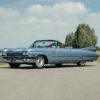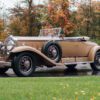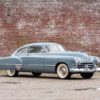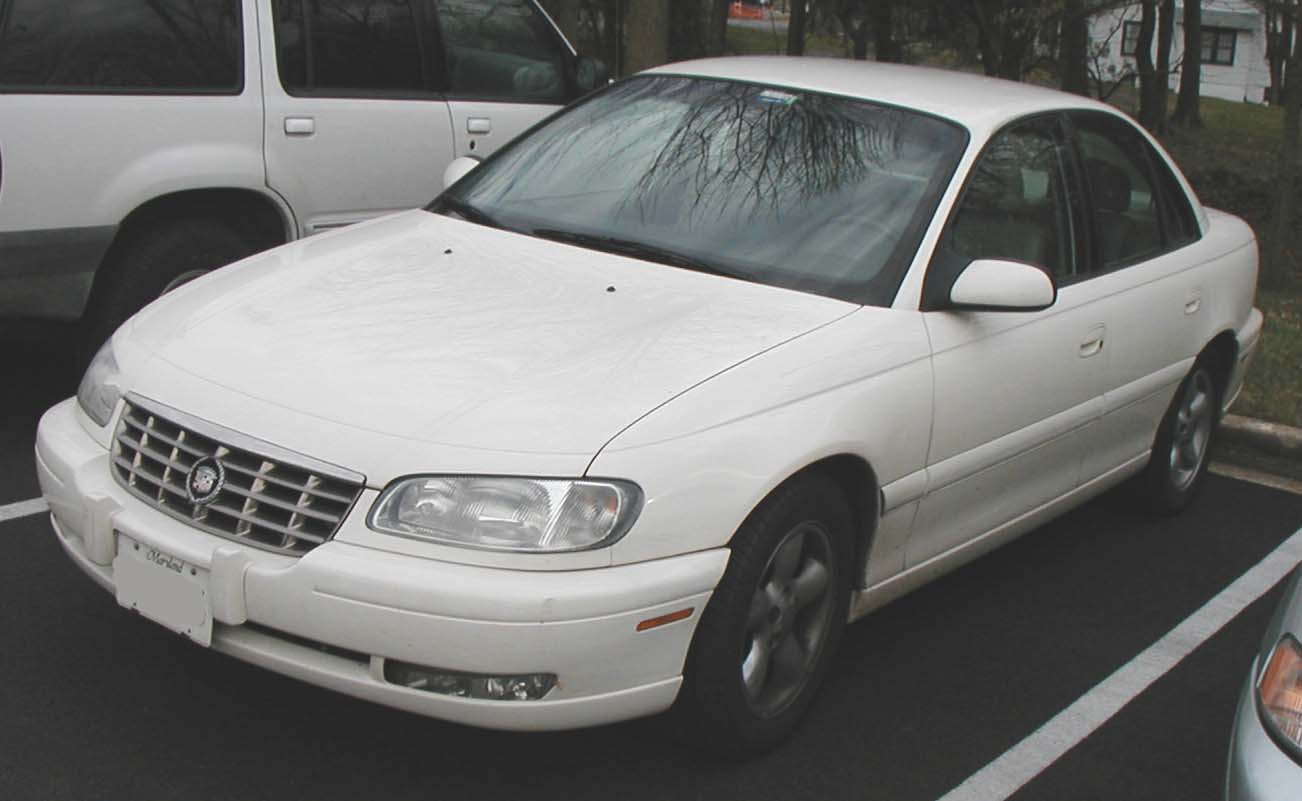Cadillac Catera Models & History 1997
Global thinking. In the often insular and nationalistic world of automobiles, it’s a radical concept. And put into practice, it can create some very radical results. Witness the all-new 1997 Cadillac Catera. Developed in Germany by an international design and engineering team, Catera is a unique and ground-breaking luxury automobile. In style, performance, and driving feel, Catera is unquestionably a fine European touring sedan, a car that would be perfectly at ease running flat out on the autobahn. Yet Catera also offers the high levels of room, comfort, convenience and safety that North American luxury car customers demand, so it’s equally satisfying on your daily commute to the office. You might say no other automobile in its class is so well-rounded.
Balancing the best elements of European and North American luxury car design, Catera offers an exhilarating driving experience. Thanks to meticulous tuning and development, the steering, powertrain, suspension and braking systems seem to act as a single, harmonious whole. On winding roads the steering feel is excellent and response to every input is consistently both positive and immediate. At speed on the highway Catera’s unwavering stability inspires driver confidence, and the ride is controlled but never harsh. Inside, the spacious, well-designed interior and generous appointments keep driver and passengers alike comfortable and relaxed. And the cabin remains calm and quiet on all roads and at all speeds. In every way, catera is an extraordinarily competent automobile.
Seen from any angle, Catera’s exterior design speaks of intelligent, purposeful engineering. Handsome 16″ aluminum wheels and low-profile all-season tires fill the wheelwells. Standard fog and cornering lamps highlight the front end. Bright chromed exhaust outlets reveal a sporting nature. And Catera’s aerodynamic body design helps improve fuel economy and quiet the interior.
“This familiar stretch of little-traveled road made me think only that the Cadillac Catera is a great automobile, a real driver’s car, and the best ride I’ve had in a long time.” — Michael Jordan, Automobile Magazine
Catera occupants enjoy more interior space than is found in many of the much higher-priced competitors. Contoured, supportive seats, electronic dual-zone climate controls and electric heaters for both front and rear seats deliver long-distance, 4-season comfort. Catera’s interior is also incredibly quiet, which makes it an excellent place to enjoy the 8-speaker stereo sound system.
“Suspension is surprisingly firm, and response to steering inputs pleasantly linear. It goes where you point it…. In other words, the Catera feels just like what it is, and what it’s supposed to be, a European sports sedan. It’s comfortable and competent, and a pleasure to drive.” — Robert English, Financial Post Magazine
Inside Catera, the details make all the difference. The 8-way power adjustable driver’s seat offers a commanding view of the road ahead. Every lever and switch operates with a satisfying, positive feel. The inside rearview mirror is an electrochromic design that dims automatically to cut glare. Even the high quality of the materials mark this as a very special automobile.
“…you can give yourself over to an excellence in the Catera’s cabin that goes beyond the high quality and feel of the materials. The driver looks down at a clear, comprehensive instrument panel, centered by a large speedometer…. Every button, knob and joystick is clearly marked and in full view of the captain.” — Road & Track
In recent years, Cadillac has become justly famous for its industry-leading Northstar System technologies. For 1997, the Northstar System is joined by a host of equally advanced technologies found exclusively in the German- engineered Catera. Consider, first, Catera’s engine. A 3.0-litre V6, it’s equipped with such advanced features as double overhead camshafts and a unique 3-mode air induction system.
Of particular note are the engine’s 12 sodium-filled exhaust valves. During driving the sodium melts and splashes around inside the valve, drawing heat away from the combustion chamber and enhancing engine efficiency. Response is excellent at all operating speeds, and full throttle unleashes no fewer than 200 well-bred horses.
No less remarkable is Catera’s electronically-controlled 4-speed automatic transmission. In its “Normal” shift mode it’s responsive and delivers maximum fuel economy. Touch a button and the transmission snaps into “Sport” mode, for extra performance. Touch another button and it goes into “Winter” mode, allowing Catera to start up from a halt in 3rd gear to make the most of the available traction.
Another important feature is Catera’s fully independent suspension, which has been carefully tuned to help maximize the car’s stability under hard braking. Catera is also equipped with a variable-assist power steering system that has been widely praised for natural, positive road feel at all speeds.
Even the rigid steel body structure has its story. It’s one of Catera’s most important safety features, with front and rear crush zones and a safety cage surrounding the passenger compartment, all for protection in the event of a crash. Of course, Catera safety goes far beyond body design. Catera’s roster of safety features is one of the most impressive in the automotive industry. Early in 1997, Catera will become one of only a few cars in North America to offer the extra crash protection of front door-mounted side air bags. These units will supplement the standard dual front air bags, which in turn supplement some of the industry’s most advanced safety belts. In a crash, tiny pyrotechnic pre-tensioners in Catera’s front shoulder belts pull the belts snug in the blink of an eye, and special clamps in the belts’ take- up reels automatically ensure they stay that way, all for enhanced protection. On paper, all this engineering prowess is impressive. On asphalt, it’s sublime.
- Launched during the 1996 model year, the midsize 1997 Catera sports sedan was a joint venture automobile developed by Cadillac and Adam Opel AG and built by Opel in Ruesselsheim, Germany, it was based on the European Opel Omega sedan platform.
- The five-passenger, rear-drive sedan was imported into the United States, and sold and serviced by more than 765 Cadillac dealers nationwide.
- The Catera’s standard features included
- dual frontal and side airbags
- four wheel disc brakes with antilock
- speed sensitive power steering
- full range traction control
- daytime running lamps
- Twilight Sentinel headlamp system
- foglamps
- remote keyless entry
- programmable power door locks
- Solar-Ray glass
- automatic dual zone climate control system
- electrochromic inside rearview mirror
- four-spoke steering wheel with remote controls for the entertainment system
- illuminated entry
- 16-inch, seven-spoke alloy wheels with Goodyear Eagle PS-A P225/55R16 tires
- Optional items included
- leather seating with front/rear seat heaters
- Bose audio system
- automatic power sunroof garage door opener
- five-spoke alloy wheels in either natural or chrome finish
- Powertrain consisted of a 3.0-liter dual overhead cam V-6 with Dual-Ram Induction and rated at 200 horsepower, paired with a 4L30-E electronically controlled four-speed automatic transmission with overdrive. This transmission featured easy-to-select Sport, Normal, and Winter driving modes.
- Final drive ratio was 3.9:1
- To enhance side-impact protection for occupants, the Catera incorporated dual steel beams in each door, reinforced body pillars, a rigid roof and a cross-car beam over the driveline tunnel.
- The Catera also featured MacPherson strut front suspension designed with advanced hydraulic control arm bushings to enhance stability of the car during hard braking.
- The rear suspension included automatic load leveling.
- Turning circle of the Catera was 34.1 feet.
- Inside, interior volume measured 111.2 cubic feet with an additional 14.5 cubic feet of trunk space.
- The rear bench seat featured a three-piece fold-down seatback for carrying long objects.
- The driver’s seat had eight-way power adjustment as well as driver and passenger font seats featuring adjustable lumbar support.
- Catera’s instrument panel featured analog gauges, including a tachometer.
- Outside, the Catera featured a contoured black chrome grille with integrated wreath-and-crest emblem and single-piece front fascia that flowed into the fenders.
- A thin chrome accent set the grille apart from the hood.
- Coefficient of drag was 0.33
STYLE
| Series No. | Body/Style No. | Body Type | Factory Price | Shipping Weight | Production Total |
| VR5 | R69 | 4-dr. Sedan | $29995 | 3770 | 25,411 |
ENGINE
| Type | 54 degree dual overhead cam V-8 |
| Construction | Cast iron block aluminum cylinder heads |
| Displacement | 181 cu. in. (3.0 liters). |
| Bore & Stroke | 3.40 x 3.40 in. |
| Compression ratio | 10.0:1 |
| Brake horsepower | 200 @ 6000 rpm. |
| Torque | 192 lb-ft @ 3600 rpm |
| Fuel supply | Variable Dual-Ram induction system |
CHASSIS
| Feature | Eldorado |
| Wheelbase | 107.4 in. |
| Overall Length | 194 in. |
| Height | 56.3 in. |
| Width | 70.3 in. |
| Front Tread | 59.3 in. |
| Rear Tread | 59.8 in. |
| Standard tires | Goodyear Eagle GS-A P225/55HR16 |
DRIVETRAIN
| Feature | Catera |
| Transmission | 4L30-E electronically controlled four-speed automatic transmission with overdrive |
| Steering | Recirculating ball, speed sensitive |
| Front Suspension | MacPherson strut lower control arms w/hydro bushing, coil spring and stabilizer bar. gas preloaded dampers, continuously variable road sensing suspension |
| Rear Suspension | Multi-link. coil spring and stabilizer bar. gas preloaded dampers, continuously variable road sensing suspension |
| Brakes | dual circuit front and roar disc w/antilock |
| Body Construction | Integral body-frame. |
| Fuel Tank | 18.0 gals. |







